Girls
Experiences of Menstruation from the Global South and North – review
In Experiences of Menstruation from the Global South and North, Kay Standing, Sara Parker and Stefanie Lotter compile multidisciplinary perspectives examining experiences of and education around menstruation in different parts of the world. Spanning academic research, activism and poetry, this thought-provoking volume advocates for inclusive approaches that encompass the diverse geographical, social, cultural, gender- and age-related subjectivities of menstruators worldwide, writes Udita Bose.
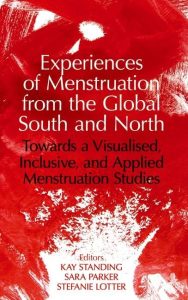 As Bobel writes in the foreword to Experiences of Menstruation from the Global South and North, “Menstruation is simultaneously everywhere and nowhere” (xvii). The book attempts to create dialogues between the Global North and Global South, recognising that menstrual experiences are a global issue, but the stigma, shame, and secrecy surrounding menstruation, make it difficult to address the various problems associated with menstruation.
As Bobel writes in the foreword to Experiences of Menstruation from the Global South and North, “Menstruation is simultaneously everywhere and nowhere” (xvii). The book attempts to create dialogues between the Global North and Global South, recognising that menstrual experiences are a global issue, but the stigma, shame, and secrecy surrounding menstruation, make it difficult to address the various problems associated with menstruation.
The book criticises how discourse about menstruation in the Global South is characterised by the development approach produced by the Global North.
The book criticises how discourse about menstruation in the Global South is characterised by the development approach produced by the Global North. In the introduction, Lotter et al argue that development approaches adopted in the Global South focusing on “alleviating poverty and working towards gender equality and improvement of living conditions” (10) have reinforced stigma associated with menstruation. This occurs because such development approaches centre the supply and demand of menstrual products, which, according to Garikipati in Chapter Seven, promotes the concealment of menstruation through the use of menstrual products (105). Lotter et a argue that a decolonial approach will help to acknowledge that countries in the Global South have made “trailblazing developments” (11) in destigmatising menstruation and tackling period poverty: Kenya ended the taxation of menstrual products long before Canada, in 2004 (11). The editors thus call for the Global North to learn from the Global South and promote a collaborative global approach when discussing menstrual experiences.
The book identifies how a lack of scientific knowledge and information about menstruation exacerbates the stigmatising of sociocultural experiences associated with it
The collaborative approach is evident in how the chapters in the collection have been organised and linked. For instance, the book identifies how a lack of scientific knowledge and information about menstruation exacerbates the stigmatising of sociocultural experiences associated with it, in the Global North and the Global South. King (Chapter Three) discusses at length how “physiology textbooks” recommended for medical students in the UK do not explain that even though menstruation is a prerequisite for conception and pregnancy, they do not inevitably follow from menstruation (24). Such emphasis on the alleged “purpose” of the menstruating body obscures the reality of the experience for women and girls. The pain, discomfort and blood loss that regularly accompany menstruation is minimised, hindering girls’ and women’s ability to respond to and understand their own bodies. This resonates with Amini’s research in Iran (Chapter 12). Amini demonstrates how most girls in Iran respond to menarche thinking that they have either lost their virginity or have a bad illness (165). These chapters show how the experience of the biological process of menstruation is conditioned by the cultural meaning it gains in a context.
Research [in Nepal] found that intersecting factors like caste, religious ideologies and ethnicity determine whether a teacher can discuss menstruation in school.
Amini’s research connects to that of Parker et al (Chapter Four) which, based in Nepal, reiterates the importance of imparting knowledge about menstruation and placing it in its sociocultural context. Their research found that intersecting factors like caste, religious ideologies and ethnicity determine whether a teacher can discuss menstruation in school. In this chapter and in the research project Dignity Without Danger – a research project launched in 2021 by Subedi and Parker developing and gathering educational resources on menstruation in Nepal (2021) – research participants noted that they were left to study the topic of menstruation on their own (38). The contextualisation of menstrual knowledge also frames the work by Garikipati (Chapter Seven) who focuses her research on menstrual products in the Indian context (103). Along with criticising the profit-driven global market, she emphasises the need to focus on sustainable development. Garikipati advocates for solutions that are tailored appropriately to the individual context (105).
The discussions on contextualising knowledge production about menstruation by researchers in diverse sociocultural and physical contexts underline the need for inclusivity. Inclusion is discussed in relation to several dimensions of menstrual knowledge production. Various researchers have captured menstrual experiences in the everyday context of the workplace (Fry et al, Chapter Eight), the school (Parker et al, Chapter Four; King, Chapter Three), the community (Garikipati, chapter Seven; Quint, Chapter Five; Macleod, Chapter 13) and the home (Amini, Chapter 12). In every setting, it is the menstruating body whose agency takes centre stage. This is enabled through the diverse and creative research methods employed by the researchers to explore menstrual experiences. For instance, Macleod (Chapter 13) had menstruating girls shoot films to narrate their menstrual experiences and held informal sessions in the schools in Gombe and Buwenge in Uganda to watch the films (190). This resonates with Lessie’s (Chapter Two) multi-sectoral approach to addressing menstruation and menstrual health. As Letsie underscores, the right to information and the right to health are basic human rights. Menstrual health is therefore a human rights issue, and its inclusion in health and development policies and programmes should be prioritised.
The book encompasses menstruating bodies at different stages of life, be it menarche or menopause
The book encompasses menstruating bodies at different stages of life, be it menarche or menopause (Weiss et al, Chapter 10), and menstruating bodies that are disabled (Basnet et al, Chapter Nine). The concluding pages of the book discuss the future prospects of research on menstruation. In doing so, Standing et al highlight the need for more research on “menstruators at margins” (230), for example, menstruators in prisons and detention centres, in humanitarian settings, sex workers, and those with disabilities. Thomson’s (Chapter 11) poem calls for normalising menstruation irrespective of gender and menopause irrespective of age, describing voluntary menopause at a young age to convert from being a female to a male (“because when I was a little girl, I knew I wasn’t…I just thank God that me and my Mother’s menopause didn’t align” 156-157). The poem echoes Lotter et al’s observation in the introduction that “not all women have periods and not all people who menstruate are women” (7). More than seeing menstruation through a lens of gender, it needs to be seen as “an issue of equity and justice” (7).
In this way, the book thus comes full circle in attempting to locate the menstruating body at the epicentre of the school and integrate all other sectors of society (family, community, policy development) into the production of knowledge on menstruation. The amplification of the need for inclusivity is particularly valuable, recognising the differences between menstrual experiences in the Global North and the Global South and challenging the gender binary, as captured in Thomson’s poetry. It is a thought-provoking volume which exposes the reader to the geographical, social, cultural, gender- and age-related subjectivities in which menstruation is experienced, examined through a variety of epistemological approaches. The book thus sets the ball rolling for further advancement of knowledge production around menstrual experiences in all their diversity.
Note: This post gives the views of the author, and not the position of the LSE Review of Books blog, or of the London School of Economics and Political Science.
Image credit: PINGO’s Forum on Flickr.
How Teen Girls in Mumbai Are Learning to Stand Tall
As Nausheen, a 14-year-old Mumbai schoolgirl, demonstrates the kicks and punches she has newly learned, there is a perceptible change in her body language. From a shy, giggly teenager, she turns into a budding supergirl: somehow she seems taller, her stance straighter and her voice louder.
“When I practice these moves, I feel a surge of power inside me,” she says. “I feel like I don’t have any fear.”
Nausheen has been learning martial arts — among other concepts such as consent and communication — at the free biweekly workshops conducted by the nonprofit MukkaMaar at her government school in a crowded Mumbai suburb. “I have learned to be strong and to face people with confidence,” she says, “whether it is my parents at home or strangers outside.”
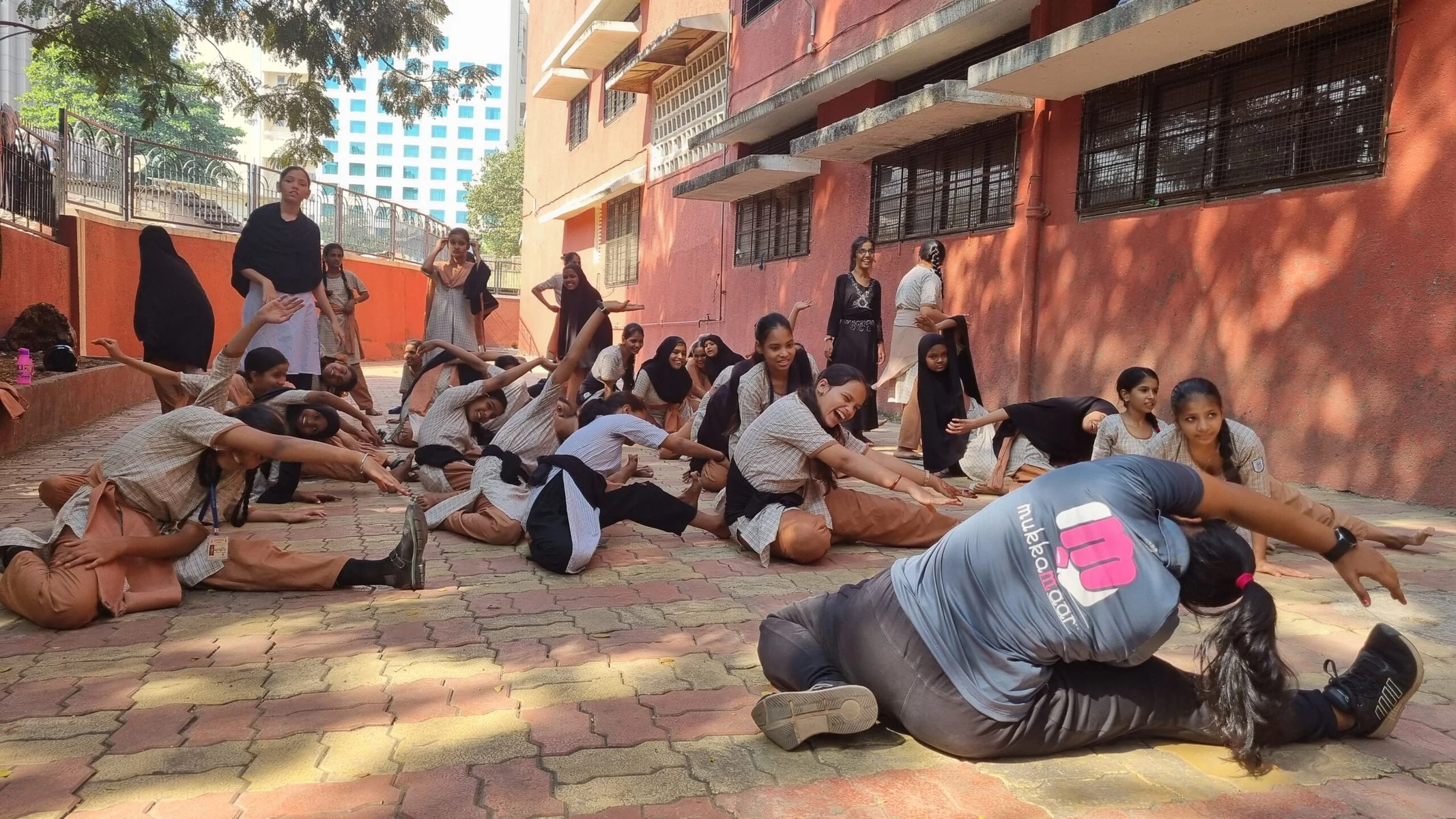 MukkaMaar partners with 56 government schools in Mumbai. Courtesy of MukkaMaar
MukkaMaar partners with 56 government schools in Mumbai. Courtesy of MukkaMaar
Contrast this with what MukkaMaar’s founder Ishita Sharma remembers from a casual conversation with a group of middle-school girls a few years ago. When asked what they would do if someone attacked them on the streets, they unanimously responded: Shout bachao bachao! (help).
“They didn’t even think about it,” Sharma says. “It was a natural response to expect someone else to come and save them, because that is what they have been taught, what they have seen in movies.”
It was with the basic aim to shift this control from the outsider to the individual that Sharma started MukkaMaar — roughly translating to “throw a punch” — as an empowerment program for adolescent girls. “Women need to take responsibility for their own safety and not succumb to the ‘What will the poor woman do?’ narrative,” she explains.
Courtesy of MukkaMaar
At MukkaMaar’s free workshops, girls learn martial arts and build confidence. They also learn about communication and consent.
Sharma began in 2016 with four girls on a public beach and the conviction that teaching self-defense was the way to empower them. Over seven years and 3,000 girls later, she has learned that along with martial arts, there is also a need for a change in fundamental beliefs and attitudes. She shares examples of how these girls are schooled to be “good daughters” who grow up to be “good wives” (for instance, to blindly marry the man chosen by their parents, as opposed to committing to a “love marriage”). She explains that there is a need to teach them to question and debate at home, negotiate for their rights, develop and assert their own personalities, and so on.
MukkaMaar now partners with 56 government schools in Mumbai, where martial arts teachers are trained to listen to and counsel the girls, who open up with their own stories. These trainers are young men and women in their late teens and 20s, who usually work in teams of two. At 19, national level boxing champion Aradhana Gaund is not much older than the girls she trains. “They treat me like their friend, and I laugh and cry with them,” she says.
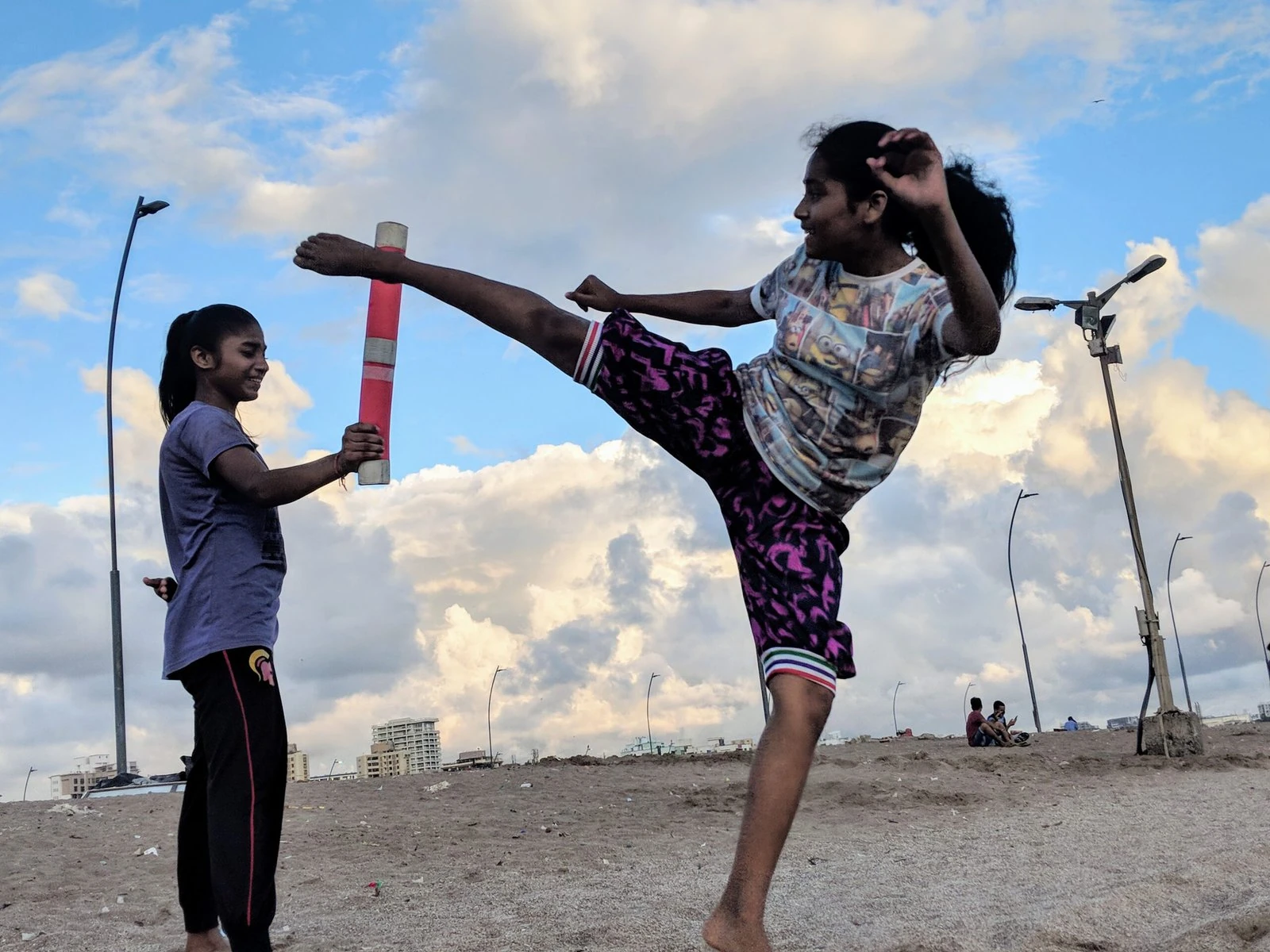 In the workshops, girls learn that violence is not a knee-jerk response, but a last resort. Courtesy of MukkaMaar
In the workshops, girls learn that violence is not a knee-jerk response, but a last resort. Courtesy of MukkaMaar
Elsa Marie D’Silva, founder of Red Dot Foundation, a nonprofit working to create safe spaces for women, says it can be intimidating for young women to stand up against harassment, and so “it is important to show them how they can speak out together, along with their friends or as a group, to call out bullies.” Indeed, this is one of the things that gives Gaund the most satisfaction: seeing how these classes have taught the girls to band together and support one another.
According to the Global Gender Gap Report 2023, India ranks a dismal 127 out of 146 countries, based on indices such as access to education, economic opportunities and health. What is even more concerning is the unceasing, systemic violence against women that takes several forms including intimate partner violence, rape and assault, dowry deaths, acid attacks and everyday street harassment.
Crushed by negative news?
Sign up for the Reasons to be Cheerful newsletter.
[contact-form-7]
Women are told from childhood to keep their heads down and take these things in stride, that to react would be futile and even dangerous. They internalize this to such an extent that they suffer harassment silently, which in turn encourages their abusers to carry on with impudence. This is where MukkaMaar has been making a small but significant difference.
Iqra, 13, says, “Earlier, I used to move away quietly when a man touched or groped me in the [public] bus. But now, I just make my voice loud and strong like I have been taught, and tell them to stop it.” At this, her friend Fatima chimes in, “Now we feel like we can also walk and talk like the boys.”
Courtesy of MukkaMaar
Ishita Sharma started MukkaMaar with the goal of changing girls’ “natural response to expect someone else to come and save them” — and showing them that they can be the ones in control.
But they have both also been taught that violence is not a knee-jerk response, but a last resort. “If we fight, we will also get hurt, but we can speak up,” Iqra declares with the wisdom of one far older.
And speak up they do, at every chance. “At my cousin’s wedding, a boy I don’t know started teasing me,” Fatima recalls. “When I shouted at him, his mother intervened and scolded him. Earlier I used to feel nervous in such situations, I used to think, ‘I am a small girl, what can I do?’”
As Sharma describes it, “We are not telling them that violence is the answer, but that violence should not be tolerated.”
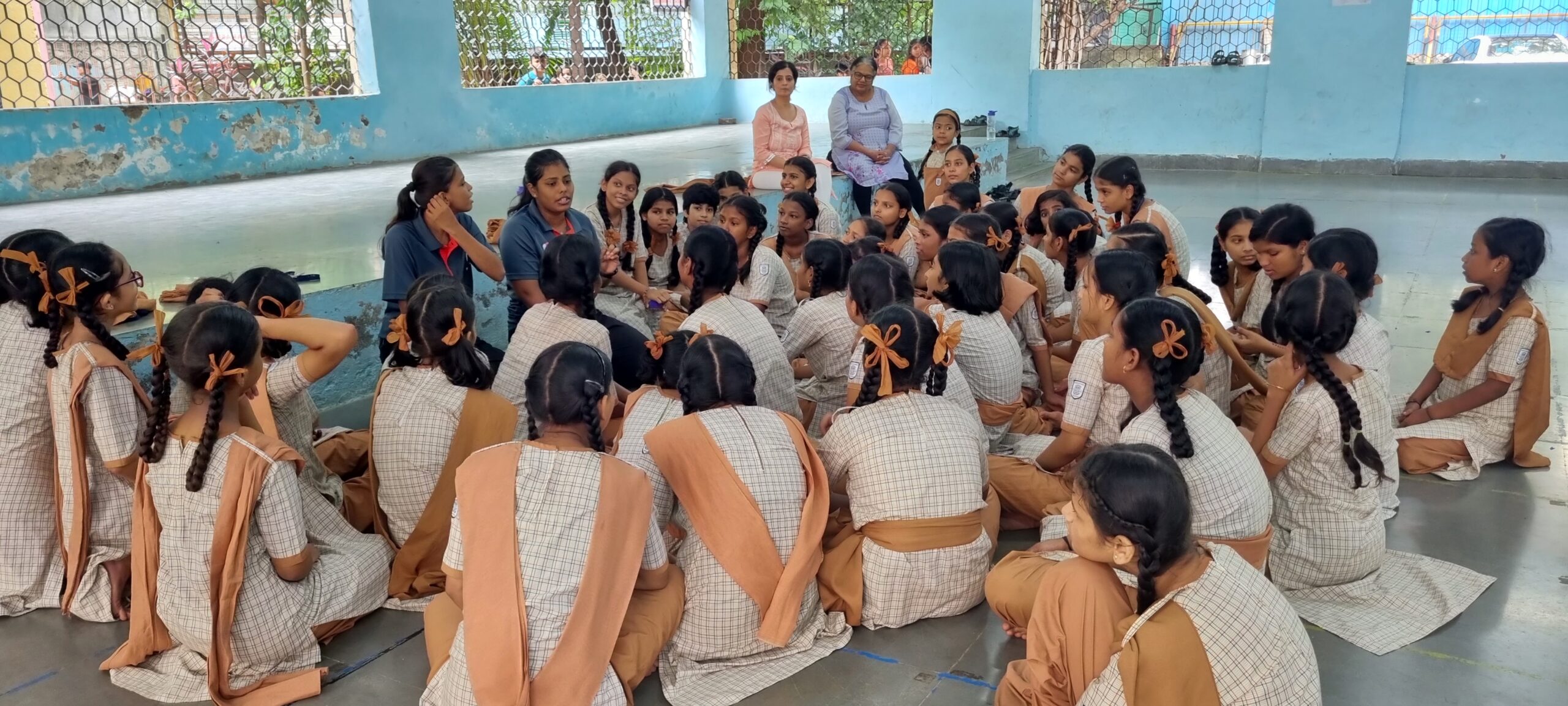 “We train them to vocalize their feelings, to open up their shoulders and lift up their chins,” explains one of MukkaMaar’s trainers. Courtesy of MukkaMaar
“We train them to vocalize their feelings, to open up their shoulders and lift up their chins,” explains one of MukkaMaar’s trainers. Courtesy of MukkaMaar
The MukkaMaar website states, “It is necessary to recognize that violence includes microaggressions, discrimination, threats, and loss of opportunity as much as assault.” The training, therefore, does not just cover self-defense but also building physical fitness and emotional strength, as well as boosting (and often instilling) self-confidence.
Senior training fellow, Bhishma Mallah, 26, who has been with MukkaMaar for over four years, says that the girls begin with so many barriers, like shame and fear, that even to get them to exercise in front of others or to express themselves verbally is a challenge. “We train them to vocalize their feelings, to open up their shoulders and lift up their chins. We have to tell them repeatedly to forget about adjusting their dupatta [traditional scarf used to cover head or shoulders] and focus on the activity.”
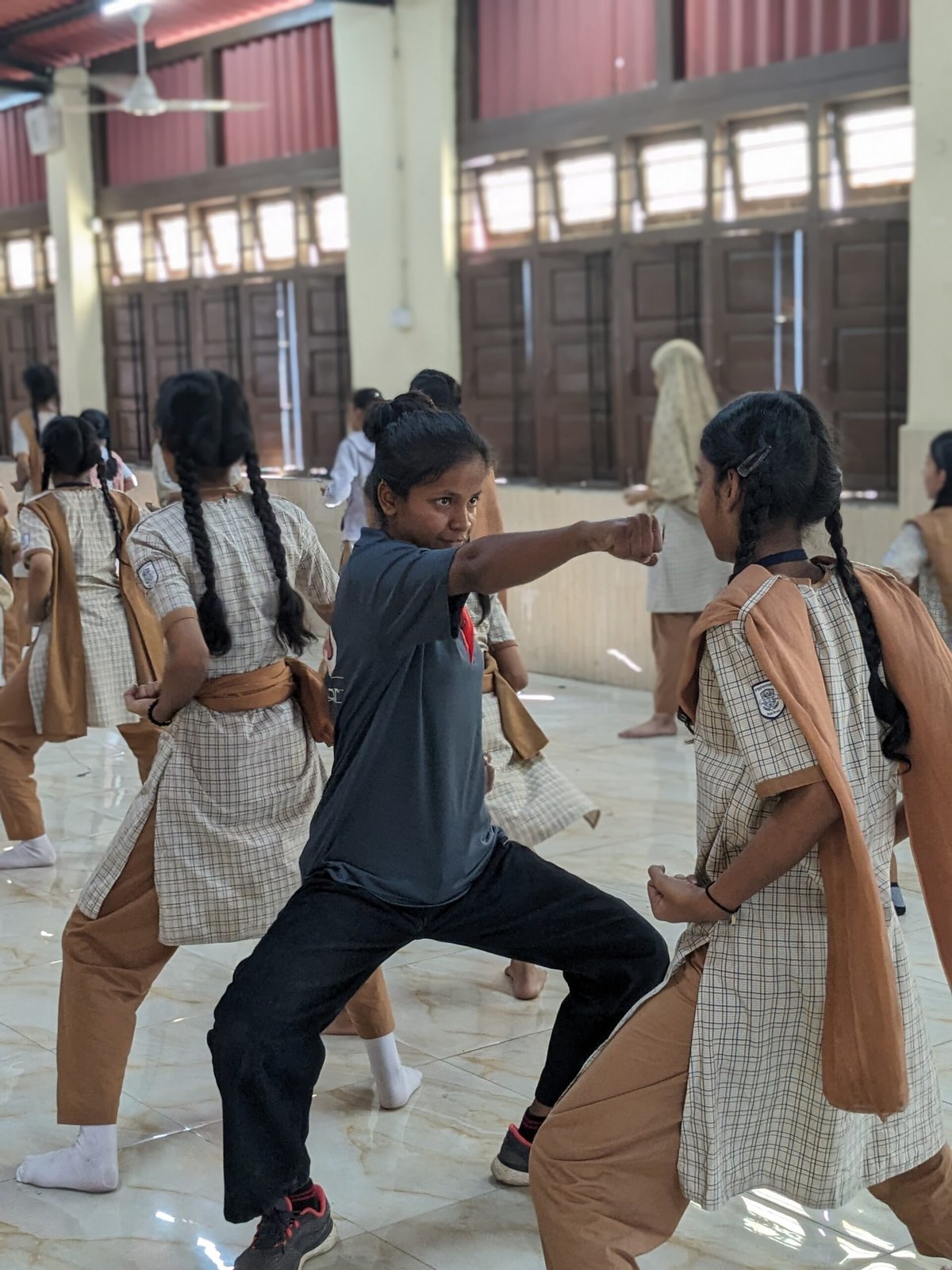 Even during workshops, the girls ask for permission before making physical contact. Courtesy of MukkaMaar
Even during workshops, the girls ask for permission before making physical contact. Courtesy of MukkaMaar
One of the many ways in which the trainers chip away at the diffidence of these young girls is by making them chant “I am important” even as they practice their moves. Or asking them to imagine how a dog growls, and to channel that aggression in their kicks and punches.
Each hour-long session includes 20 minutes of conversations and counseling, with the remaining time devoted to physical training. “We teach them about concepts like boundaries, consent and safe touch. Even during lessons, they have to take permission from their partner before any physical contact,” explains Mallah.
Sharma admits it took her a couple of years to realize that for a girl to build agency, there is a lot of familial and social conditioning that needs to be undone. “There is no point in teaching them martial arts alone, with its focus on discipline and technique — because unless we teach them critical thinking, it is all pointless, and forgotten the minute they step out of the classroom,” says Sharma.
Red Dot Foundation founder D’Silva adds a word of caution: “It’s not enough to just empower the girls to speak up, it is also the responsibility of adults to listen to them when they do. If their parents or teachers don’t take them seriously, then the child will quickly learn not to tell anyone — because there is the added fear of having their personal freedom curtailed under the guise of protecting them or saving the family honor.”
A change in the larger ecosystem may take a long time, but it is clear that something is shifting within these girls. While one cohort confronted a cop making a video call in front of them and challenged him to prove he was not taking their photos without permission, another group of girls gathered the courage to file a police complaint against their physical education teacher who had been harassing them. For others, it has meant something as seemingly trivial as talking back to their fathers and challenging gendered rules and restrictions.
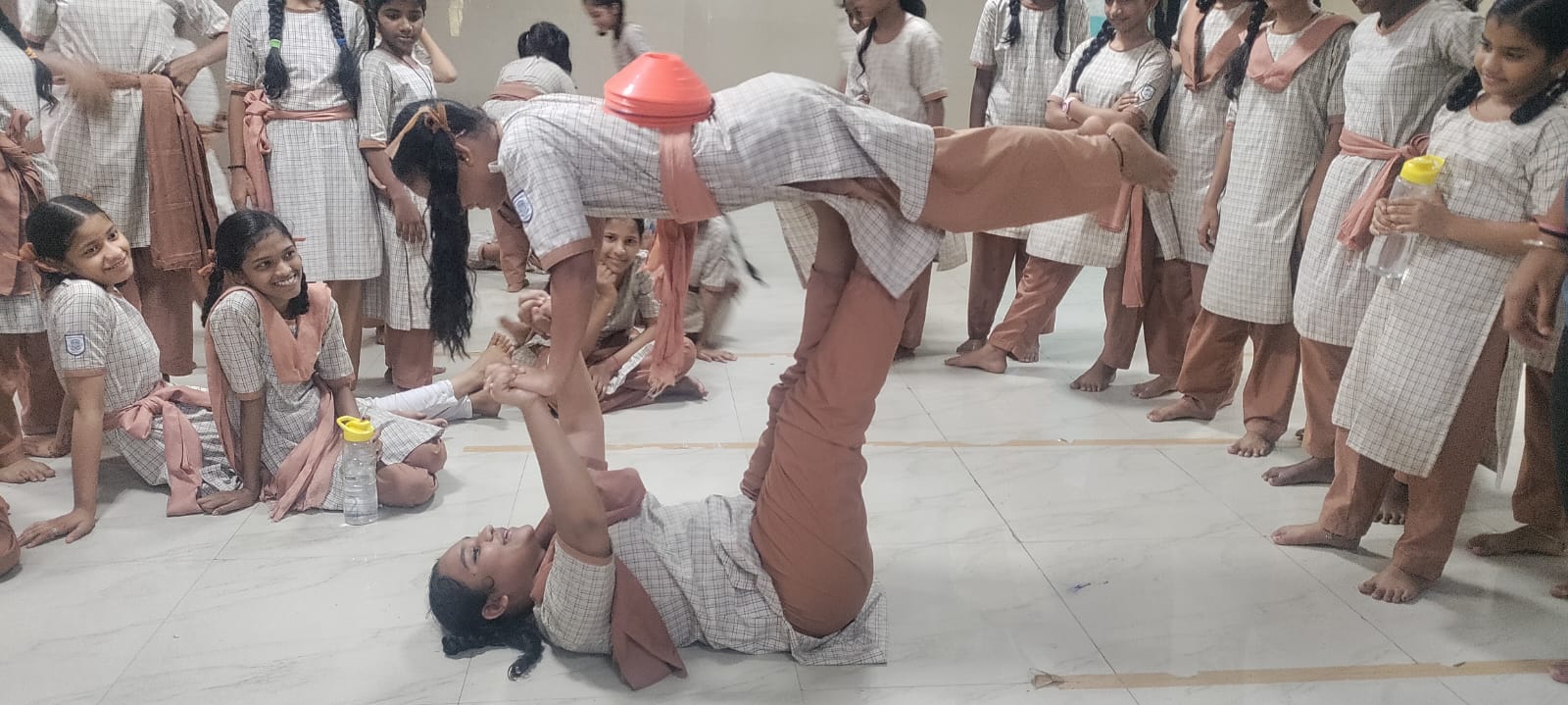 “I have learned to be strong and to face people with confidence,” one MukkaMaar student says, “whether it is my parents at home or strangers outside.” Courtesy of MukkaMaar
“I have learned to be strong and to face people with confidence,” one MukkaMaar student says, “whether it is my parents at home or strangers outside.” Courtesy of MukkaMaar
These may seem like small incidents, but for these young girls in Mumbai, the freedom to think independently and challenge those around them has been life-changing.
In the short run, Sharma says MukkaMaar wants to focus on fewer places and create retention, rather than spread the program thin all over the city. The future is digital for MukkaMaar alumni, with a chatbot that helps the girls have a two-way conversation about self-defense techniques, physical fitness, understanding of different types of gender violence and soft skills like communication and negotiation. This keeps them connected to the program, and to everything they learned in it, even after they leave.
The post How Teen Girls in Mumbai Are Learning to Stand Tall appeared first on Reasons to be Cheerful.
UN human rights office ‘appalled’ at rape and execution of women and girls in Gaza
‘Credible’ reports of war crimes against Palestinian women by Israeli soldiers detailed in UN OHCHR statement – yet ignored by western ‘msm’
The horrific treatment of women and girls by Israeli soldiers – including rape and execution – has been condemned by the United Nations Commissioner for Human Rights in a damning statement today from the ‘Special Procedures’ group of human rights experts, saying that the actions of the IDF are likely to amount to prosecutable war crimes.
The statement says that the group:
expressed alarm over credible allegations of egregious human rights violations to which Palestinian women and girls continue to be subjected in the Gaza Strip and the West Bank.
Palestinian women and girls have reportedly been arbitrarily executed in Gaza, often together with family members, including their children, according to information received.
“We are shocked by reports of the deliberate targeting and extrajudicial killing of Palestinian women and children in places where they sought refuge, or while fleeing. Some of them were reportedly holding white pieces of cloth when they were killed by the Israeli army or affiliated forces,” the experts said.
The experts expressed serious concern about the arbitrary detention of hundreds of Palestinian women and girls, including human rights defenders, journalists and humanitarian workers, in Gaza and the West Bank since 7 October. Many have reportedly been subjected to inhuman and degrading treatment, denied menstruation pads, food and medicine, and severely beaten. On at least one occasion, Palestinian women detained in Gaza were allegedly kept in a cage in the rain and cold, without food.
“We are particularly distressed by reports that Palestinian women and girls in detention have also been subjected to multiple forms of sexual assault, such as being stripped naked and searched by male Israeli army officers. At least two female Palestinian detainees were reportedly raped while others were reportedly threatened with rape and sexual violence,” the experts said. They also noted that photos of female detainees in degrading circumstances were also reportedly taken by the Israeli army and uploaded online.
The experts expressed concern that an unknown number of Palestinian women and children, including girls, have reportedly gone missing after contact with the Israeli army in Gaza. “There are disturbing reports of at least one female infant forcibly transferred by the Israeli army into Israel, and of children being separated from their parents, whose whereabouts remain unknown,” they said.
“We remind the Government of Israel of its obligation to uphold the right to life, safety, health, and dignity of Palestinian women and girls and to ensure that no one is subjected to violence, torture, ill-treatment or degrading treatment, including sexual violence,” the experts said.
They called for an independent, impartial, prompt, thorough and effective investigation into the allegations and for Israel to cooperate with such investigations.
“Taken together, these alleged acts may constitute grave violations of international human rights and humanitarian law, and amount to serious crimes under international criminal law that could be prosecuted under the Rome Statute,” the experts said. “Those responsible for these apparent crimes must be held accountable and victims and their families are entitled to full redress and justice,
While Israel’s atrocity propaganda claiming ‘systematic’ use of rape as a weapon of war have been characterised by an absence of evidence and a demand to be believed regardless how lurid and unfeasible the claims have been, and have quickly collapsed under scrutiny – yet have been propagated by western media and governments anyway – the UN experts’ sober claims carry weight and a call for serious investigation, but has been entirely ignored so far by the UK and US ‘mainstream’ media:
SKWAWKBOX needs your help. The site is provided free of charge but depends on the support of its readers to be viable. If you’d like to help it keep revealing the news as it is and not what the Establishment wants you to hear – and can afford to without hardship – please click here to arrange a one-off or modest monthly donation via PayPal or here to set up a monthly donation via GoCardless (SKWAWKBOX will contact you to confirm the GoCardless amount). Thanks for your solidarity so SKWAWKBOX can keep doing its job.
If you wish to republish this post for non-commercial use, you are welcome to do so – see here for more.

